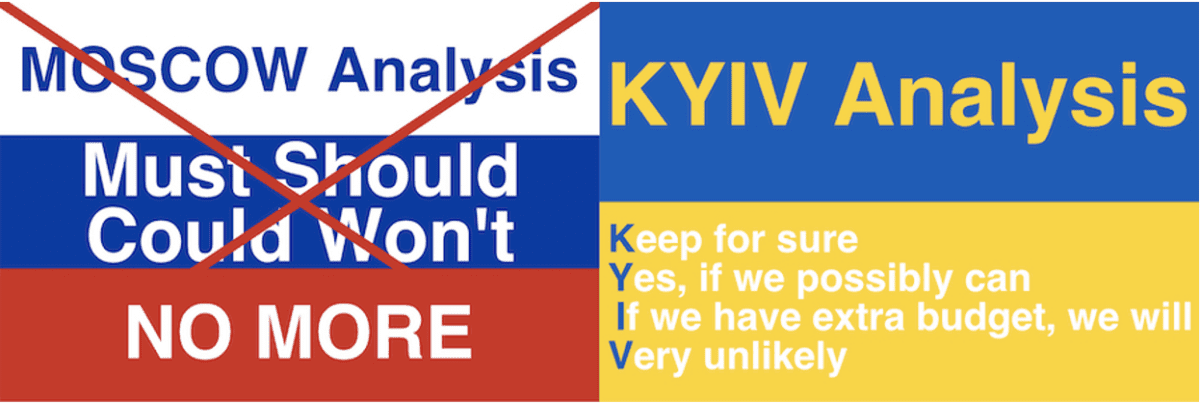
Accurately defining the scope of a project and getting stakeholder signoff early on is one of the keys to project success. It is incumbent upon you to get your scope right during the definition stage.
For a deeper dive into defining scope and getting stakeholders on-board, refer to the previous article – Scope Creep: How to Prevent a Major Source of Project Failure.
This article provides an overview of the scoping process in four steps.
Step 1: Gather Requirements
It starts with a robust requirements-gathering stage, which requires understanding the needs, desires, and priorities of each stakeholder. Then we run into the simple fact that makes scoping the most difficult part of Project Management (in my view). You will never have the resources to deliver all the things that all stakeholders want. Further, you will also likely face competing priorities and even conflicting needs among those stakeholders.
Step 2: Negotiate with Stakeholders
So, the second step is careful stakeholder negotiation, meeting with your stakeholders individually and collectively to negotiate who gets what. This means facing up to the essential truth:
You can please all of your stakeholders some of the time. And you can please some of your stakeholders all of the time. But you won’t be able to please all of your stakeholders all of the time.
Step 3: Clarify Priorities
While it’s a great first step, sometimes, meticulous negotiation won’t get you the clarity and consensus you need. So, step three may be to introduce a simple facilitation tool to help stakeholders identify, discuss, and balance their priorities. A familiar tool is MoSCoW Analysis. However, in recent years, I have come to favor an alternative I developed: KYIV Analysis.

Step 4: Thoroughly Document Scope
Finally, and crucially, we must make a thorough documentation of requirements and scope. This is your consensus document or document set. Use this as the basis for sign-off – and a baseline for change control.
Preventing Scope Creep is Not Always the Right Thing to Do
Freezing scope is a nice ideal. But, in the real world within which we work,
- Requirements and priorities change
- New opportunities emerge
- The market moves underneath us
- We run into technical challenges
- We find new ways to do things
So, our objective is not to prevent change: it is to manage it.
Traditional Project Management
In traditional approaches to Project Management, this means a Change Control process.
The essence of change control is to subject every request for change – to specification, schedule, design, or scope – to robust scrutiny. We need to evaluate the costs, risks, and other implications of the change, and compare them to the marginal benefit of committing to the change. Just as with our initial business case, we need to evaluate the value proposition in the proposal.
Adaptive Project Management
Multiple strands of adaptive (or Agile) thinking have converged on an alternative approach to controlling scope. This makes use of the concept of a ‘backlog’. Rather than determine which scope items we will commit to early on, we record and define every suggestion.
A backlog is a list (usually structured by priority) of all the user requirements and requests. When we plan a period of work – usually called an ‘iteration’ or ‘Sprint’ – we draw down a number of those elements from this backlog. These form the workload for the iteration. For the next iteration, we prioritize from among the remaining backlog items, stopping when the incremental cost of another iteration exceeds the incremental value of the highest-priority backlog items.
Throughout the project, we can add ideas into the backlog. Then, periodically, the team will re-assess the backlog for new ideas, overlaps, and redundant ideas, in a process called ‘backlog grooming’.
In this way, adaptive projects build managing scope change into the process from the outset.
Conclusion
Scope creep kills projects. The definition and management of scope is therefore one of the most critical elements of a Project Manager’s workload. And, beyond this, it is about keeping your project under control and ensuring accountability for, and good governance of, the decision process that determines how we will use our time, spend our money, and deploy our resources.
Related Content
Scope Creep: How to Prevent a Major Source of Project Failure
Mastering Project Estimation: Simplified Techniques for Reliable Scheduling
#How Many of These 8 Stakeholder Analysis Tools Do You Know?
Elevate your project management skills and propel your career forward with an MPUG Membership. Gain access to 500+ hours of PMI-accredited training, live events, and a vibrant online community. Watch a free lesson and see how MPUG can teach you to Master Projects for Unlimited Growth. JOIN NOW







